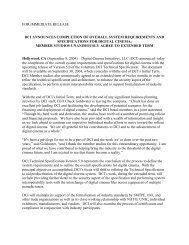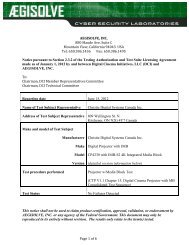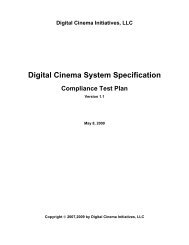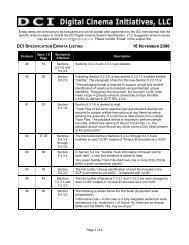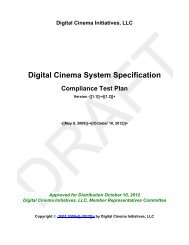DCI Specs - Digital Cinema Initiatives
DCI Specs - Digital Cinema Initiatives
DCI Specs - Digital Cinema Initiatives
Create successful ePaper yourself
Turn your PDF publications into a flip-book with our unique Google optimized e-Paper software.
• This RRP can be used by the SMS to direct an SM to initiate a TLS (re)connect,though this may be done also at the TCP layer.9.4.5.3.3.3. AbortThis command, Abort, terminates an open RRP that is: 1) instigated by theoriginal recipient’s lack of response, or 2) forced by the original recipient.The Abort command interrupts an open RRP by interjecting the abort before theoriginal recipient responds. The recipient of any RRP can issue this commandresponse in place of the originally requested response. No parameters are sentin either the request or response.RRP Requester RespondentSuccessful SM (or SMS) no longer is waiting forRRP(id) responseSE (or SM) aborts its RRP(id)response ambitionsUnsuccessful Error event<strong>DCI</strong> <strong>Digital</strong> <strong>Cinema</strong> System Specification v.1.2 Page 125Table 18: RRP State: AbortNotes:• It shall not be permitted for an SE to abort a QuerySPB RRP.• The responder must respond to the Abort request, even if the original RRP(id)response happens to have been sent (race condition is OK).9.4.6. ForensicsForensics do not prevent content theft or other compromises, but rather, it provides methodsfor their detection and investigation. Forensic features deter attackers who are aware thattheir actions would be logged and/or reported in considerable detail.Forensic features fall into two classes: Forensic Marking (FM) and logging. Forensic Markingembeds tracking information into content itself, to be carried into subsequent legitimate orstolen copies. Logging creates records of both normal and abnormal events in theDistribution and Exhibition process. During a content theft investigation, both FM andlogging information may be combined to establish the details of the security compromise.Industry terminology for watermarking and Forensic Marking is not consistent. For thesesecurity specification purposes, stakeholders have agreed to use the term Forensic Markingfor all content marks.9.4.6.1. Forensic MarkingThese specifications require that image and audio Forensic Marking (FM) capability beincluded in each Image Media Block.The security system identifies content markingdevices (e.g., Forensic Marking embedders) as the “FM” Security Entity (SE) type. Tosupport FM processes, standardized Intra-Theater Messaging (ITM) may be used whereneeded for communications between such SEs and Security Managers (SMs). Suchcommunications and associated FM behavior is outside of this specification. Howeverthe requirements of ITM Section 9.4.5 Intra-Theater Communications shall be mandatorywhere such theater messaging employs the intra-auditorium security network. ForensicMarking does not require interoperability between detection systems, as the detectionoperation is usually performed “off line” as part of a security investigation.Multiple solutions may be qualified and will allow Media Block solutions providers toselect the solution of their choice. Candidate providers should meet with individualstudios to discuss RAND and technical suitability of their approach.




